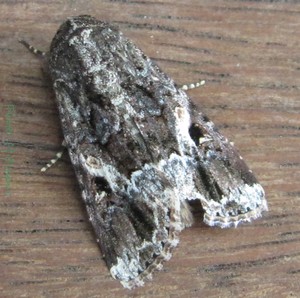Lawn armyworm facts for kids
Quick facts for kids Lawn armyworm |
|
|---|---|
 |
|
| Scientific classification | |
| Synonyms | |
|
The lawn armyworm, also known as the paddy swarming caterpillar, is a type of moth. Its scientific name is Spodoptera mauritia. This moth was first described by Jean Baptiste Boisduval in 1833.
Lawn armyworms are known for eating many different kinds of plants. Because of this, they are considered a major pest in many parts of the world. They can cause a lot of damage to crops and grassy areas.
Contents
Where Do Lawn Armyworms Live?
Lawn armyworms are found in many places around the world. They live in areas from the Red Sea all the way to India and Myanmar. You can also find them in Sri Lanka and the Malay Peninsula.
They are common in Australia and many Pacific Islands. This includes places like the Solomon Islands, Fiji, Samoa, and Hawaii. They also live in the Marquesas Islands and Marshall Islands.
What Do Lawn Armyworms Look Like?
Adult lawn armyworm moths have a wingspan of about 40 millimeters (about 1.5 inches). Their bodies are dark grey-brown, sometimes with a reddish color. The lower part of their body, called the abdomen, is a dull brownish color.
Their front wings have faint, wavy lines. They have a small, yellowish spot and a darker, blackish spot. Sometimes, you can see a white patch between these spots. The back wings are shiny white and almost clear, with a dark line along the edge.
What Do Lawn Armyworms Eat?
The young lawn armyworms, called larvae or caterpillars, love to eat different types of grasses. This includes important crops like rice and wheat. They also feed on grasses like Cynodon and Pennisetum clandestinum.
They can also eat plants like Sorghum bicolor and even trees such as Casuarina equisetifolia. Because they eat so many plants, they are a big problem for farms and pastures around the world.
Interestingly, when these caterpillars are older (in their sixth instar), they get rid of waste differently. Instead of uric acid, they excrete urea, which is unusual for insects.
How They Cause Trouble and How to Stop Them
Damage to Plants
When lawn armyworm caterpillars attack plants, they cause a lot of damage. They can chew holes in leaves or eat away the soft parts, leaving only the veins. This is called "skeletonized leaves." They can also cause stems to die.
Sometimes, a whole field of rice can be destroyed in just a few days. This happens when many caterpillars swarm and eat everything.
Stopping the Pests
Farmers use different ways to control these pests. One simple method is "hand picking," where people remove the caterpillars by hand. Other mechanical methods are also used to reduce the number of pests.
To get rid of adult moths, some farmers introduce bolas spiders into their fields. These spiders are amazing because they can spray a special scent. This scent is like the one female moths use to attract males. Male moths fly towards the scent and get caught by the spider.
Tiny worms called nematodes can also help. These nematodes are natural enemies of the armyworms. Viruses like Nucleopolyhedrovirus are also used to control outbreaks.
Another way to catch adult moths is by using special traps. These include "wing traps" and "unitraps" that collect the moths.
Past Problems with Lawn Armyworms
Lawn armyworms have caused serious problems in different countries.
- In 1969, a large outbreak in Sarawak, Malaysia, affected 6,000 square miles. This attack caused a 20% loss in Malaysia's total rice production.
- In 1981, armyworms severely damaged rice nurseries in Indonesia. This made it harder to plant new rice crops.
- In Sri Lanka, major outbreaks happened in 1904 and 1920. In these events, rice farms in Jaffna were destroyed by the caterpillars.
- In 2016, a big outbreak in Assam, India, damaged over 17,418 hectares (about 43,000 acres) of farmland across 10 districts.
Subspecies
There are two main types, or subspecies, of Spodoptera mauritia:
- S. m. mauritia (found near the Indian Ocean)
- S. m. acronyctoides Guenée, 1852 (found in tropical Asia, Australia, Pacific tropics, and Japan)

